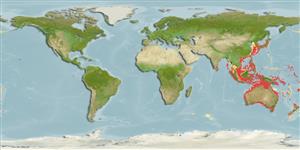>
Lophiiformes (Anglerfishes) >
Histiophrynidae (Starfingered frogfishes)
Etymology: Histiophryne: Greek, istion, istos = sail + Greek, phryne = toad (Ref. 45335).
More on author: Weber.
Environment: milieu / climate zone / depth range / distribution range
Ecología
marino asociado a arrecife; rango de profundidad 5 - 130 m (Ref. 9563). Subtropical
Distribución
Países | Áreas FAO | Ecosistemas | Ocurrencias, apariciones | Point map | Introducciones | Faunafri
Western Pacific.
Tamaño / Peso / Age
Maturity: Lm ? range ? - ? cm
Max length : 9.6 cm TL macho / no sexado; (Ref. 90102)
Short description
Claves de identificación | Morfología | Morfometría
Espinas dorsales (total) : 3; Radios blandos dorsales (total) : 13 - 16; Radios blandos anales: 6 - 9.
Found inshore on reefs (Ref. 7300) but has been recorded to a depth of 130 m (Ref. 9563). Adults found with sponges or ascidians (Ref. 48635). Oviparous. Eggs are attached to each other by a single, flattened, acellular filament and are brooded in a hollow behind the left pectoral fin (Ref. 6773). Mimics sponges with its spots that resembles pores of sponges (Ref 90102).
Life cycle and mating behavior
Maturities | Reproducción | Spawnings | Egg(s) | Fecundities | Larva
Oviparous (Ref. 205).Eggs are attached to each other by a single, flattened, acellular filament and are brooded in a hollow behind the left pectoral fin (Ref. 6773).
May, J.L. and J.G.H. Maxwell, 1986. Trawl fish from temperate waters of Australia. CSIRO Division of Fisheries Research, Tasmania. 492 p. (Ref. 9563)
IUCN Red List Status (Ref. 130435)
Threat to humans
Harmless
Human uses
Herramientas
Special reports
Download XML
Fuentes de Internet
Estimates based on models
Preferred temperature (Ref.
123201): 14.8 - 28.8, mean 26.1 °C (based on 1242 cells).
Phylogenetic diversity index (Ref.
82804): PD
50 = 0.5312 [Uniqueness, from 0.5 = low to 2.0 = high].
Bayesian length-weight: a=0.01995 (0.00906 - 0.04395), b=3.01 (2.83 - 3.19), in cm total length, based on all LWR estimates for this body shape (Ref.
93245).
Nivel trófico (Ref.
69278): 3.7 ±0.6 se; based on size and trophs of closest relatives
Resiliencia (Ref.
120179): Alto, población duplicada en un tiempo mínimo inferior a 15 meses (Fec assumed to be > 10,000).
Fishing Vulnerability (Ref.
59153): Low vulnerability (10 of 100).
